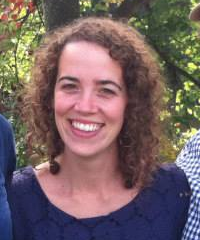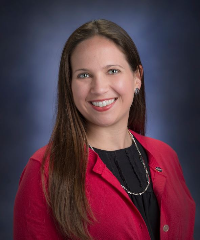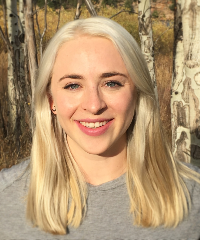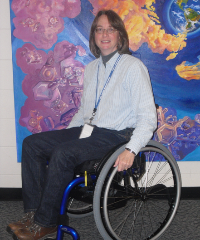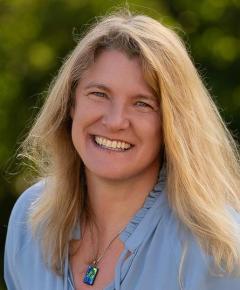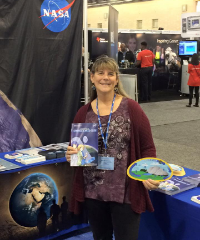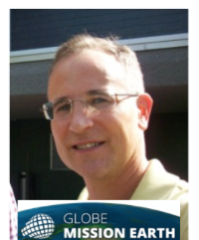Community Blogs
Community Blogs
Discover how the GLOBE community is engaging in all things GLOBE through the community blog posts below.
Learn how to create a GLOBE community blog post.
Filter By:
Blogs List
Sun is shining having blue Sky .
Read More »
Posted in:
Sky is clear but clouds are here .
Posted in:
The University of New Hampshire Carbon Cycle team has started to curate a list of resources that compliment GLOBE Carbon Cycle activities and Protocols . These include videos, websites, peer reviewed articles, and a Q&A section with Dr. Scott Ollinger , ecosystem ecologist at UNH and PI on the Carbon Cycle Project.
These resources have been sent to us over the past few years, and have found a home here: https://www.globe.gov/web/leitzel-center/home/carbon-cycle-resources . As we encounter more, we will continue to build this list. If you have resources that ...
Posted in:
The NASA GLOBE Clouds team at NASA Langley Research Center is working with NASA scientist Dr. Bill Smith to use GLOBE Cloud observations made by people just like you to solve the Terminator Problem!
Wait, what? Well, the Solar Terminator or twilight zone is that line that separates the daylit side of a planet from the dark night side. The image on the left is an example. It was taken from the International Space Station as it crossed the terminator on April 17, 2019 as it orbits 254 miles above the Gulf of Guinea on Africa’s mid-western coast.
...
Posted in:
Curriculum:
EDUCATION RESEARCH
SCIENCE AND MATH
TECHNOLOGY
STEM
GLOBE Science Topics:
BACKYARD SCIENCE
CLIMATE
CLIMATE CHANGE
DATA INCLUDED
GENERAL SCIENCE
GLOBE PROTOCOLS
EARTH AS A SYSTEM
EARTH SYSTEM SCIENCE
SCIENTIST SKILLS
Investigation Areas:
ATMOSPHERE
EARTH AS A SYSTEM
Learning Activities:
ATMOSPHERE AND CLIMATE
EARTH AS A SYSTEM
News Topics:
COMMUNITY LETTERS
NEWS BRIEFS
Student Research Reports:
STANDARD RESEARCH REPORT
INTERNATIONAL VIRTUAL SCIENCE SYMPOSIUM REPORT
U.S. STUDENT RESEARCH SYMPOSIA (SRS)
Have you ever seen a tree snap due to high winds or a lightning strike?
Back in March 2020, I saw a beautiful Bradford Pear tree starting to bloom with its pale yellow-white blossoms. I thought that this would be a very nice, isolated tree to take a NASA GLOBE Observer tree height observation.
Tree Height - March 15, 2020, 19.41m, Bradford Pear, Salisbury, Maryland USA
Let's fast forward to August 4, 2020. At this time, the Mid-Atlantic region of the United States was being greatly affected by the remnants of Hurricane Isaias. By this time, the hurricane was ...
Posted in:
Our universe may be filled with unseen giants. Astronomers have discovered two giant radio galaxies, which are some of the largest-known objects in the universe. This revelation suggests that the enormous galaxies may be more common than previously believed.
The study published Monday in the Monthly Notices of the Royal Astronomical Society.
Astronomers found the two galaxies in new radio maps that were created using the MeerKAT radio telescope in South Africa.
Radio galaxies, which can be quite common, are brightest in radio wavelengths of light. Centaurus A ...
Posted in:
All the content goes here. Use the + to add photos.
Posted in:
In May 2020, citizen scientist Carmen Mandel met two major milestones: she marked her one-year anniversary of being a GLOBE Observer and she single-handedly expanded the Clouds satellite match data by 36%. Carmen uses GLOBE Observer to record clouds 2-3 times daily every time she gets a notification that a NASA satellite is overhead. She sends her data to GLOBE, but then she records her observation in her own clouds journal. When she receives an email from NASA Langley Research Center matching her observation to satellite data, she adds that to her journal as ...
Posted in:
GLOBE Science Topics:
BACKYARD SCIENCE
DATA INCLUDED
EARTH SYSTEM SCIENCE
GENERAL SCIENCE
Investigation Areas:
ATMOSPHERE
CLOUDS
Primary Audience:
ALUMNI
COUNTRY COORDINATORS
SCIENTISTS
STUDENTS
Have you ever wondered what happens after you press submit on your International Virtual Science Symposium (IVSS) report?
The GLOBE Implementation Office (GIO) Education team gets to work!
Ok, that might be a little misleading because work on the IVSS already started back in August when we started planning for the 2021 IVSS. And while learning about planning webinars and recruiting judges might be something you are interested in; this is not what this blog post will cover. This is the “story” of what happens after teachers upload their students’ projects and press the big blue ...
Posted in:
News Topics:
VIRTUAL SCIENCE FAIR
Primary Audience:
ALUMNI
COUNTRY COORDINATORS
PARTNERS
SCIENTISTS
STUDENTS
TEACHERS
TRAINERS
Student Research Reports:
INTERNATIONAL VIRTUAL SCIENCE SYMPOSIUM REPORT
Images taken by Wilson Bentley and property of the Jericho Historical Society.
Did you know that clouds have names? As the title of the GLOBE Elementary book says, clouds do have names. Those names describe the altitude and the appearance of the cloud. Cumulus means pile in Latin, so the name is used to describe low puffy clouds in the sky. Cirrus means locks of hair, and is used to describe those thin wispy clouds found high up in the sky. Some people think that nimbus is a type of cloud, but it is not. It is an affix, or a word that works as a prefix or a suffix. ...
Posted in:
Curriculum:
ASSESSMENT AND EVALUATION
GLOBE Science Topics:
BACKYARD SCIENCE
Investigation Areas:
ATMOSPHERE
Learning Activities:
ATMOSPHERE AND CLIMATE
News Topics:
COMMUNITY LETTERS
Primary Audience:
ALUMNI
Lectures, lessons, and learning opportunities of all kinds are available online these days… luckily, air quality investigations can be, too! Publically available sources of air quality data, which can be accessed any time and anywhere, can be used in conjunction with or in lieu of the GLOBE Aerosols Protocol for students and teachers participating in the US Air Quality Student Research Campaign. This blog post will introduce a website which can be used to conduct air quality investigations with a ground-based instrument, called the PurpleAir.
The PurpleAir is a small, commercially ...
Posted in:
Lectures, lessons, and learning opportunities of all kinds are available online these days… luckily, air quality investigations can be, too! Publically available sources of air quality data, which can be accessed any time and anywhere, can be used in conjunction with or in lieu of the GLOBE Aerosols Protocol for students and teachers participating in the US Air Quality Student Research Campaign. This blog post will introduce a website called AerosolWatch, an online access point for satellite-based observations of aerosols, and factors that affect air quality (such as smoke and dust). ...
Posted in:
The big announcement this month was that we made the difficult decision to cancel the 2021 Student Research Symposia. We have some other activities that we will working on instead, which will support the IVSS and SRS into the future! In other news, I attended a couple virtual multi-day meetings and had lots of resources cross my desk. Some of those are listed below. I look forward to 2021 and the close of 2020. It has been a rough year but kindness abounds and teachers are amazing in supporting students throughout this public health crisis – they inspire me each day. Peace to all of the ...
Posted in:
Ever wonder what it might be like to work for NASA? This year at the American Geophysical Union (AGU) Annual Meeting (kind of like a huge IVSS as it is virtual this year), NASA shared a wealth of resources to help anyone interested in working with or for NASA to "find their place"! Take a look at this site and explore the myriad of amazing opportunities and programs that exist for a wide variety of different audiences. These programs range from research and learning opportunities to being engaged by being a part of The GLOBE Program! So check out the " Find Your Place " ...
Posted in:
Curriculum:
EDUCATION RESEARCH
LANGUAGE CULTURE AND ARTS
SCIENCE AND MATH
TECHNOLOGY
STEM
Field Campaigns:
FLEXE
SCRC
SCUBANAUTS
SEASONS AND BIOMES
WATERSHEDS
CARBON CYCLE
GGIC
SCRC - PHASE 1
SCRC - PHASE 2
SMAP
EL NIÑO
SURFACE TEMPERATURE
GPM
GLOBE Science Topics:
BACKYARD SCIENCE
CLIMATE
CLIMATE CHANGE
DATA INCLUDED
GENERAL SCIENCE
GENERAL SCIENCE @ES
EARTH AS A SYSTEM
EARTH SYSTEM SCIENCE
SCIENTIST SKILLS
MEETINGS/CONFERENCES
GLOBE Working Groups:
EVALUATION WORKING GROUP
SCIENCE WORKING GROUP
EDUCATION WORKING GROUP
TECHNOLOGY WORKING GROUP
Investigation Areas:
ATMOSPHERE
HYDROSPHERE
EARTH AS A SYSTEM
PEDOSPHERE (SOIL)
BIOSPHERE
Learning Activities:
ATMOSPHERE AND CLIMATE
EARTH AS A SYSTEM
HYDROLOGY
LAND COVER/BIOLOGY
SOIL
News Topics:
MEETINGS
SCRC RESEARCH
TRAINING
VIRTUAL SCIENCE FAIR
Primary Audience:
ALUMNI
COUNTRY COORDINATORS
PARTNERS
SCIENTISTS
STUDENTS
TEACHERS
TRAINERS
Student Research Reports:
STANDARD RESEARCH REPORT
INTERNATIONAL VIRTUAL SCIENCE SYMPOSIUM REPORT
U.S. STUDENT RESEARCH SYMPOSIA (SRS)
MISSION EARTH REPORT
MISSION MOSQUITO REPORT
Teacher's Guide:
GRADE LEVELS
INVESTIGATION AREA DOCUMENTS
It snowed at my house in Michigan last week, the first week of December 2020. I love snow and I really like to see how snow affects the surface temperature. Between 60 and 80 mm of snow was on the ground. I took surface temperature observations as part of the Urban Heat Island Student Research Campaign. I wanted to show what you could do by yourself at your house if you have an infrared thermometer.
My two sites are my backyard which is grass and the gravel driveway in the front of our house. The backyard has a line of Black Spruce trees just south of where I am standing in the ...
Posted in:
Field Campaigns:
SURFACE TEMPERATURE
Did you know that your pace is a vital part of taking observations of tree height and land cover? A pace is a unit of length consisting either of one normal walking step, or of a double step, returning to the same foot, your dominant foot. Pacing Image above courtesy of Rothwell-Osnabruch K-12 School - Ontario, Canada The NASA GLOBE Observer Trees Tool uses your height to estimate your step length, which it then uses to estimate the distance to the tree, but you can also measure your pace directly, which will make your tree height measurements more accurate. Want to learn ...
Posted in:
WOOHOO! It’s time to celebrate! The NASA GLOBE Observer just had its 25,000th citizen science tree height observation. The observation came in on November 30, 2020 from Corvallis, Oregon. Since the release of the NASAGO Trees Tool on March 26, 2019, there has been an average of 40 tree height observations taken per day across the GLOBE Program participant countries.
Do you want to take tree height observations too? Check out https://observer.globe.gov/do-globe-observer/trees . Your tree height observations are so important to science research and exploration:
- Tree ...
Posted in:
Scientists are wondering what is happening over Antarctica and where are the noctilucent clouds. Noctilucent clouds or polar mesospheric clouds are the highest occurring cloud types (form about 50 miles or 80 Km above the Earth's surface). They form in the Mesosphere and are thin clouds made up of ice crystals that form from left over fine dust from meteors. Because they are so high up in the sky, you see them when the sun is low or almost nighttime. The form during the summer months over the north and south poles. That is when it is coldest that high up in the sky ( in the mesosphere ...
Posted in:
GLOBE Science Topics:
CLIMATE
CLIMATE CHANGE
Investigation Areas:
ATMOSPHERE
EARTH AS A SYSTEM
Primary Audience:
ALUMNI
COUNTRY COORDINATORS
PARTNERS
SCIENTISTS
STUDENTS
TEACHERS
TRAINERS
The Chang'e-5 robotic mission landed a few hours ago on lunar soil and aims to collect samples of rock and dust to bring them back to Earth.
The venture targets a site called Mons Rümker, a volcanic complex in a nearby region known as Oceanus Procellarum.The spacecraft's landing module should spend the next few days examining its surroundings and gathering materials from the lunar surface.The intention is to pack about 2 kilos of materials, which will then be sent to a module that can transport the samples to Earth.
It has been 44 years since that same goal was last ...
Posted in:
Fall is a whirlwind of virtual meetings! We had the GLOBE
North American Regional Meeting in mid-October and I
attended some of the sessions of the GLOBE
Europe and Eurasia Regional Meeting . I guess that is one
positive from the move to virtual meetings; it opens the
opportunity to attend if you cannot travel. Some things that came
across my desk this month…
Grant opportunity for Maryland schools: https://cbtrust.org/grants/environmental-education/
National Monitoring
Conference (virtual) April 19-24, 2021 ...
Posted in:
—
20 Items per Page







